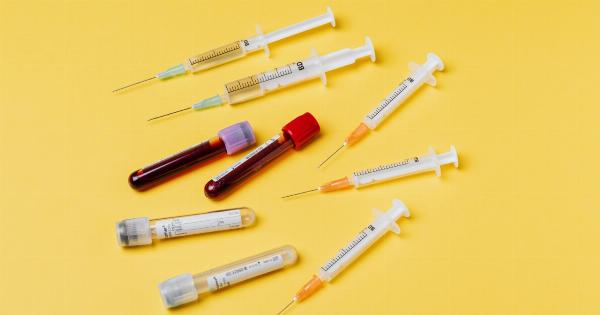An aneurysm is a medical condition characterized by a bulging or swelling in the wall of a blood vessel. It occurs when the weakened area of the vessel becomes enlarged and increases the risk of rupture.
A ruptured aneurysm can be life-threatening, leading to internal bleeding and potential organ damage. Early detection plays a crucial role in preventing aneurysm complications and improving treatment outcomes. In this article, we will explore the importance of early detection and discuss various methods of prevention.
Understanding Aneurysms
Aneurysms can develop anywhere in the body, but the most common types occur in the brain, aorta (the large artery that carries blood from the heart to the rest of the body), and the arteries in the legs. There are two main types of aneurysms:.
1. Cerebral Aneurysms
Cerebral aneurysms, also known as intracranial aneurysms, occur within the brain and can pose a significant risk if left untreated.
They are often asymptomatic until they rupture, leading to a potentially life-threatening condition called subarachnoid hemorrhage. Early detection of cerebral aneurysms can help prevent rupture and associated complications.
2. Abdominal Aortic Aneurysms (AAA)
Abdominal aortic aneurysms primarily affect the major vessel supplying blood to the lower body. They often develop slowly over time and may remain unnoticed until they rupture or cause symptoms such as abdominal pain or pulsating sensations.
Early detection of AAA is essential to implement appropriate preventive measures and reduce the risk of rupture.
Symptoms of Aneurysms
In many cases, aneurysms do not produce any noticeable symptoms until a rupture occurs. However, specific warning signs and symptoms may arise, depending on the location and size of the aneurysm. Some common symptoms include:.
1. Cerebral Aneurysms
– Sudden severe headache.
– Stiff neck.
– Blurred or double vision.
– Sensitivity to light.
– Seizures.
2. Abdominal Aortic Aneurysms (AAA)
– Abdominal or lower back pain.
– Pulsating sensation in the abdomen.
– Digestive issues.
– Fatigue or weakness.
Diagnostic Procedures
Early detection of aneurysms is crucial to prevent ruptures and serious complications. Healthcare providers may recommend different diagnostic procedures based on the suspected aneurysm’s location:.
1. Imaging Tests
– CT (Computed Tomography) Scan: A CT scan creates detailed cross-sectional images of the brain, abdomen, or other parts of the body, allowing healthcare professionals to visualize aneurysms with excellent precision.
– MRI (Magnetic Resonance Imaging): MRI uses strong magnetic fields and radio waves to generate detailed images of internal organs. It is particularly useful for assessing cerebral aneurysms.
– Angiography: This involves injecting a contrast dye into the blood vessels, which helps highlight any abnormalities, including aneurysms, during X-ray imaging.
2. Ultrasound
– Abdominal Ultrasound: This non-invasive imaging test utilizes sound waves to create images of the abdomen, including the aorta, facilitating the detection of abdominal aortic aneurysms.
Prevention Strategies
While aneurysms cannot always be prevented, adopting certain lifestyle changes and utilizing medical interventions can significantly lower the risk:.
1. Healthy Lifestyle Habits
– Quit Smoking: Smoking is a major risk factor for the development and progression of aneurysms. Quitting smoking can significantly reduce the risk of aneurysm formation and rupture.
– Maintain a Balanced Diet: Consuming a diet rich in fruits, vegetables, whole grains, and lean proteins can support overall cardiovascular health and decrease the risk of aneurysms.
– Exercise Regularly: Engaging in physical activity for at least 150 minutes per week can help maintain optimal circulatory function and reduce the likelihood of aneurysm development.
2. Medications
– Blood Pressure Control: Managing high blood pressure is crucial in preventing aneurysms. Healthcare professionals may prescribe medications to control blood pressure and decrease the stress on blood vessel walls.
3. Surgical Interventions
– Brain Aneurysm Clipping or Coiling: In cases of cerebral aneurysms at high risk of rupture, surgical procedures like clipping or coiling can be performed to prevent subsequent bleeding.
– Endovascular Aneurysm Repair: For abdominal aortic aneurysms, a minimally invasive procedure called endovascular repair may be recommended. It involves inserting a stent graft to reinforce the weakened area of the aorta.
Conclusion
Early detection is the key to aneurysm prevention, as it enables timely interventions and reduces the risk of ruptures.
By understanding the different types of aneurysms, recognizing their symptoms, and undergoing appropriate diagnostic tests, individuals can take proactive steps towards preventing complications. Adopting a healthy lifestyle, managing underlying medical conditions, and exploring surgical options when necessary contribute to the overall management and prevention of aneurysms.





























